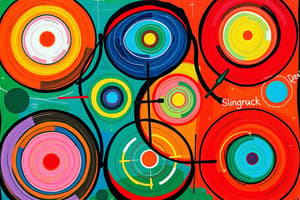Podcast
Questions and Answers
What type of feedback is given before and during the performance?
What type of feedback is given before and during the performance?
- Intrinsic Feedback
- Concurrent Feedback (correct)
- Extrinsic Feedback
- Delayed Feedback
Closed-loop control relies on pre-programmed instructions without feedback.
Closed-loop control relies on pre-programmed instructions without feedback.
False (B)
What phase of skill acquisition is characterized by high variability in performance?
What phase of skill acquisition is characterized by high variability in performance?
Cognitive Phase
The ______ focuses on the effect of the movement rather than the movement itself.
The ______ focuses on the effect of the movement rather than the movement itself.
Match the stages of learning with their descriptions:
Match the stages of learning with their descriptions:
Which theorist’s model includes the initial stage of learning?
Which theorist’s model includes the initial stage of learning?
Schema theory is based on executing movements without feedback.
Schema theory is based on executing movements without feedback.
What are two factors that influence skill acquisition?
What are two factors that influence skill acquisition?
Study Notes
Feedback And Performance
-
Types of Feedback:
- Intrinsic Feedback: Information gained through sensory input during or after performance.
- Extrinsic Feedback: Information provided by an external source (coach, video analysis).
-
Functions of Feedback:
- Reinforcement of correct performance.
- Correction of errors.
- Motivation and encouragement.
-
Timing of Feedback:
- Concurrent Feedback: Given during the performance.
- Delayed Feedback: Given after the performance, allowing for reflection and processing.
Motor Control Theories
- Closed-Loop Control: Relies on feedback from the performance; allows for error correction.
- Open-Loop Control: Executes movements without feedback; relies on pre-programmed instructions.
- Schema Theory: Skills are represented by generalized motor programs that adjust to different contexts.
- Ecological Approach: Focuses on perception-action coupling and environmental interaction.
Skill Acquisition Processes
-
Phases of Skill Acquisition:
- Cognitive Phase: Understanding the task, high variability in performance.
- Associative Phase: Practicing and refining skills, reduced variability.
- Autonomous Phase: Performance becomes more automatic and requires less conscious thought.
-
Factors Influencing Skill Acquisition:
- Practice type (blocked vs. random).
- Amount of practice.
- Quality of feedback.
Movement Analysis
-
Techniques for Analysis:
- Qualitative and quantitative analysis methods.
- Use of video technology for detailed feedback.
-
Focus Areas:
- Kinematics (movement patterns).
- Kinetics (forces involved in movements).
- Biomechanics (structural and functional effects on movement).
Cues for Improving Performance
-
Types of Cues:
- External Cues: Focuses on the effect of the movement (e.g., target).
- Internal Cues: Focuses on the movement itself (e.g., body position).
-
Effective cueing strategies:
- Short, concise phrases.
- Visual or verbal prompts tailored to the athlete’s understanding.
Stages of Learning
-
Fitts and Posner Model:
- Cognitive Stage: Learning what to do; requires attention.
- Associative Stage: Learning how to do it; connecting cues and feedback.
- Autonomous Stage: Skill is automatic; can focus on strategy.
-
Gentile's Model:
- Initial Stage: Understand the task requirements and movement dynamics.
- Later Stage: Adapting movement to various contexts and refining techniques.
Skill Classification
-
Types of Skills:
- Gross Motor Skills: Involve large muscle groups (e.g., running).
- Fine Motor Skills: Involve smaller muscle groups (e.g., typing).
-
Classification Dimensions:
- Open Skills: Performed in unpredictable environments (e.g., soccer).
- Closed Skills: Performed in predictable environments (e.g., archery).
-
Continuous vs. Discrete Skills:
- Discrete Skills: Clear beginning and end (e.g., a single jump).
- Continuous Skills: No clear start or finish (e.g., swimming).
Feedback And Performance
- Feedback can be intrinsic (sensory information) or extrinsic (external sources).
- Functions of feedback include reinforcement, error correction, motivation, and encouragement.
- Concurrent feedback is provided during performance, while delayed feedback is provided afterwards.
Motor Control Theories
- Closed-loop control uses feedback for error correction.
- Open-loop control relies on pre-programmed instructions and lacks feedback.
- Schema theory proposes skills are generalized motor programs adapted to different contexts.
- The ecological approach emphasizes perception-action coupling and environmental interaction.
Skill Acquisition Processes
- Skill acquisition progresses through cognitive, associative, and autonomous phases.
- The cognitive phase focuses on understanding the task.
- The associative phase involves practicing and refining skills.
- The autonomous phase achieves automated performance with reduced conscious effort.
- Factors like practice type, amount of practice, and feedback quality influence skill acquisition.
Movement Analysis
- Movement analysis can be qualitative (observational) or quantitative (measuring specific variables).
- Video technology facilitates detailed feedback.
- Focus areas include kinematics (movement patterns), kinetics (forces involved), and biomechanics (structural and functional effects).
Cues for Improving Performance
- Cues can be external (focused on movement effect) or internal (focused on movement itself).
- Effective cueing uses short, concise phrases and tailored prompts for better understanding.
Stages of Learning
- The Fitts and Posner model includes cognitive, associative, and autonomous stages.
- The cognitive stage focuses on learning task requirements.
- The associative stage connects cues and feedback to refine performance.
- The autonomous stage automates performance, allowing focus on strategy.
- Gentile's model distinguishes between initial stages (understanding task and dynamics) and later stages (adapting movements to various contexts).
Skill Classification
- Skills can be classified as gross (large muscle groups) or fine (smaller muscle groups).
- Open skills are performed in unpredictable environments, while closed skills are executed in predictable settings.
- Continuous skills lack a clear start or finish, while discrete skills have distinct beginnings and ends.
Studying That Suits You
Use AI to generate personalized quizzes and flashcards to suit your learning preferences.
Description
This quiz explores the types, functions, and timing of feedback in performance contexts. It also delves into various motor control theories, highlighting concepts like closed-loop and open-loop systems, as well as schema and ecological approaches. Test your understanding of how feedback influences motor skills.




